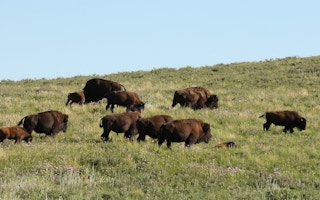Three-quarters of all the world’s protected areas – bits of ocean and wilderness nominally made safe for animals, birds, fish, amphibians, reptiles, plants and fungi produced by 500 million years of evolution – may not be sufficiently staffed or funded.
And of 12,000 species of amphibians, birds and mammals whose ranges include protected areas, fewer than one in 10 are safely within properly policed and cared-for parks and reserves.
Researchers report in the journal Frontiers in Ecology and the Environment that they looked at a sample of more than 2,100 protected areas in Africa, South America and Asia to see which could be classed as sufficiently funded and staffed.
Only 22.4 per cent of these – covering a total area of about 25 per cent of the total areas assessed – could claim to be sufficiently or well resourced.
The news comes only weeks after UN chiefs warned that up to a million species around the globe could be at risk of imminent extinction, and researchers found that many areas declared protection zones for the wilderness were being reclassified, degraded or exploited by industry and agribusiness.
“
Most protected areas are poorly funded and therefore failing to protect wildlife on a scale sufficient to stave off the global decline in biodiversity.
James Watson, director of science and research initiative, Wildlife Conservation Society
Protection fails
“This analysis shows that most protected areas are poorly funded and therefore failing to protect wildlife on a scale sufficient to stave off the global decline in biodiversity,” said James Watson, of the University of Queensland in Australia and the Wildlife Conservation Society.
“Nations need to do much more to ensure that protected areas fulfil their role as a major tool to mitigate the growing biodiversity crisis.”
The researchers also identified 11,919 species of bird, amphibian and mammal that might have natural ranges that included protected areas, and made estimates of those that could be sure of properly protected areas within their range.
They found that this represented 4 per cent of amphibians, 8 per cent of birds and 9 per cent of mammal species in the sample. This is at least five times lower than the targets protected areas were supposed to meet.
Humans usurp nature
That there is a biodiversity crisis has been established and confirmed, again and again. It has been driven by the fourfold explosion both in human population and in the advancement of global economies just in the 20th century, as humans have colonised savannah, forest and wetland to build cities, establish farms and exploit minerals.
The climate crisis, driven by a remorseless rise in global average temperatures in turn driven by profligate use of fossil fuels, can only intensify the hazard to the other species which share the planet, recycle the air and water, scavenge detritus and provide the primary foodstuffs and fibres on which humans depend.
Researchers have also repeatedly established that properly protected wilderness areas offer a way of slowing climate change. And almost on a daily basis, fresh studies identify the cascade towards extinction.
Research in the journal Nature Ecology and Evolution reveals that since 1900, at least 571 species of seed plant have been extinguished. The researchers also say that “almost as many may have been erroneously declared extinct and then been rediscovered”, but even that caveat simply highlights the numbers that might be nearing oblivion, and reinforces the call for effective protection of natural habitat.On paper, around 15 per cent of the global terrestrial surface and about 12 per cent of marine areas are under national protection, and nations are on track to match a global commitment to protect 17 per cent of land surface and 10 per cent of the seas by 2020, under an internationally agreed strategic plan for biodiversity.
The implication of the latest studies is that “on paper” isn’t good enough. Even if nations can claim to be on target, that doesn’t mean the wild things the protected areas are intended to protect are very much safer.
“While continued expansion of the world’s protected areas is necessary, a shift in emphasis from quantity to quality is critical to effectively respond to the current biodiversity crisis,” said the researchers.
And Professor Watson warned that without such a shift, conservationists could risk “sending a false message that sufficient resources are being committed to biodiversity protection.”
This story was published with permission from Climate News Network.

















